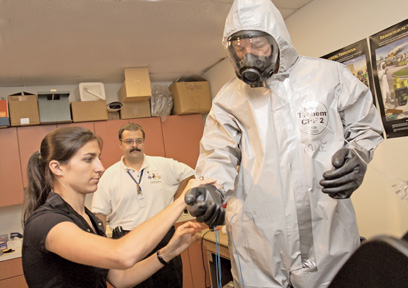Pitt Awarded Grant to Assess Heat Stress in Firefighters

Mike Dortenzo (right), chief of the Guyasuta, Pa., Volunteer Fire Department (VFD), takes part in a Fire ground Rehab Evaluation (FIRE) Trial exercise in Pitt’s Emergency Responder Human Performance Lab. Assisting him is David Hostler, a research assistant professor in Pitt’s Department of Emergency Medicine and a volunteer firefighter with the Guyasuta VFD, and Pitt School of Education student
Jennifer Seitz.
Researchers in the Pitt School of Medicine’s Department of Emergency Medicine, in collaboration with the Allegheny County Fire Academy, have received a $222,000 Federal Emergency Management Agency (FEMA) grant to study the best way to reduce firefighters’ risk of heart problems from exposure to heat stress.
According to a July 2007 National Institute for Occupational Safety and Health report, sudden cardiac death is the most common cause of line-of-duty deaths among firefighters, killing approximately 45 each year. It is suspected that many of these deaths are triggered by heat stress. The report also found that, for firefighters, coronary artery disease and sudden cardiac death involve a combination of personal and work-related factors.
Personal factors can include age, gender, family history, diabetes, hypertension, smoking, high cholesterol, obesity, and lack of exercise. Work-related factors can include exposure to fire smoke, heavy physical exertion, heat stress, and other physical stresses.
The two-year Pitt-Allegheny County Fire Academy study, known as the Fire ground Rehab Evaluation (FIRE) Trial, will assess the best methods for maintaining the health and safety of firefighters while in the line of duty; such health maintenance is called fire ground rehabilitation.
Currently, fire ground rehabilitation is inconsistent across the fire and rescue profession, in which taking a break can be viewed as a sign of weakness.
“During the FIRE trial, we will be looking for the right threshold at which fire ground rehabilitation should be administered and investigating the efficacy of different methods of rehabilitation that can be administered at fire scenes,” said David Hostler, a research assistant professor in Pitt’s emergency medicine department and a volunteer firefighter in the Guyasuta Volunteer Fire Department in O’Hara Township. “The study is designed to improve firefighter health and safety by providing an improved understanding of the mechanisms of heat stress and its effects on the heart. We anticipate that the study will result in improved methods of prevention and treatment of heat-related cardiovascular stress that can be adopted by fire departments across the United States,”
Firefighters from the Guyasuta Volunteer Fire Department and other departments across Allegheny County will be tested in the Pitt emergency medicine department’s Emergency Responder Human Performance Lab.
Physiological monitoring will include pulse, heart rate, blood pressure, and core body temperature, while at rest and during exercise and while wearing firefighters’ protective clothing. Blood samples will be taken before and after exercise to look for elevations in chemicals that promote blood clotting and are associated with increased cardiovascular risk. After exercise, various cooling and hydration treatments will be administered (orally administered fluids versus IV fluids, for example) to determine the most practical and effective method to reduce cardiovascular risk in firefighters. Similar tests will be performed during exposure to fire, smoke, and heat when the firefighters are training at the Allegheny County Fire Academy.
Coinvestigators of this trial include Joe Suyama, a Pitt assistant professor of emergency medicine, and Steven Reis, the University’s associate vice chancellor for clinical research, health sciences, and a professor of medicine. Reis also is a volunteer firefighter and medical officer of the Guyasuta Volunteer Fire Department.
After completing the study, researchers will submit a list of recommendations to the FEMA Assistance to Firefighter Program for implementation by fire departments across the country.
Other Stories From This Issue
On the Freedom Road

Follow a group of Pitt students on the Returning to the Roots of Civil Rights bus tour, a nine-day, 2,300-mile journey crisscrossing five states.
Day 1: The Awakening
Day 2: Deep Impressions
Day 3: Music, Montgomery, and More
Day 4: Looking Back, Looking Forward
Day 5: Learning to Remember
Day 6: The Mountaintop
Day 7: Slavery and Beyond
Day 8: Lessons to Bring Home
Day 9: Final Lessons

